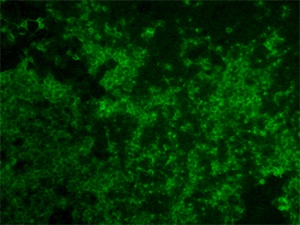
Infected cells stained with anti-Chikungunya virus plasma
© 2011 American Association of Immunologists
Chikungunya fever, caused by the Chikungunya virus, is a mosquito-borne, infectious disease endemic to Africa and Southeast Asia. The symptoms of Chikungunya fever range from acute high fever to rheumatoid arthritis (chronic joint pain). There is currently no vaccine or treatment for Chikungunya fever, and the disease could be fatal to individuals with a weak immune system. Lucile Warter at the A*STAR Singapore Immunology Network and co-workers have now derived from an individual who had previously been infected but subsequently recovered from Chikungunya fever two powerful antibodies that could neutralize a variety of Chikungunya virus strains.
The researchers isolated antibody-synthesizing cells from the individual, and then characterized the antibodies that these cells produced. In cell culture experiments, they found two antibodies that were able to prevent the Chikungunya virus from entering into the host cells and inhibit the virus from spreading from one infected cell to an uninfected one. “These antibodies may be useful not only for protecting human beings from being infected with the Chikungunya virus, but also for treating individuals who are infected with the virus,” explains Warter.
The antibodies efficiently blocked the infectivity of different Chikungunya virus strains obtained from Singapore, Africa and Indonesia. The result shows that the antibodies can target a broad range of Chikungunya virus strains and should therefore be useful for the eventual development of a treatment for the Chikungunya virus.
The Chikungunya virus belongs to a group of viruses called alphaviruses. Although the antibodies could also neutralize a closely related alphavirus called o’nyong-nyong virus, another mosquito-borne infectious disease with symptoms common to Chikungunya fever, tests showed they were not effective against other alphaviruses. The antibodies bound to proteins on the Chikungunya virus envelope, which is on the outer surface of the virus. The differences between the envelope proteins of the alphaviruses may explain the variable efficacies of the antibodies in fighting infection by the different alphaviruses tested.
“The identification of these Chikungunya protein components recognized by human neutralizing antibodies provides insight into the way that the Chikungunya virus interacts with its human host,” says Warter. While further experiments are needed to determine whether the antibodies can also combat the Chikungunya virus infection in vivo in animal models, the isolation and characterization of these antibodies constitute a first step in drug development to fight this fast-spreading virus. In addition, the new findings provide important insights that could help dissect the mechanisms underlying Chikungunya virus-associated chronic arthritis.
The A*STAR-affiliated researchers contributing to this research are from the Singapore Immunology Network.



